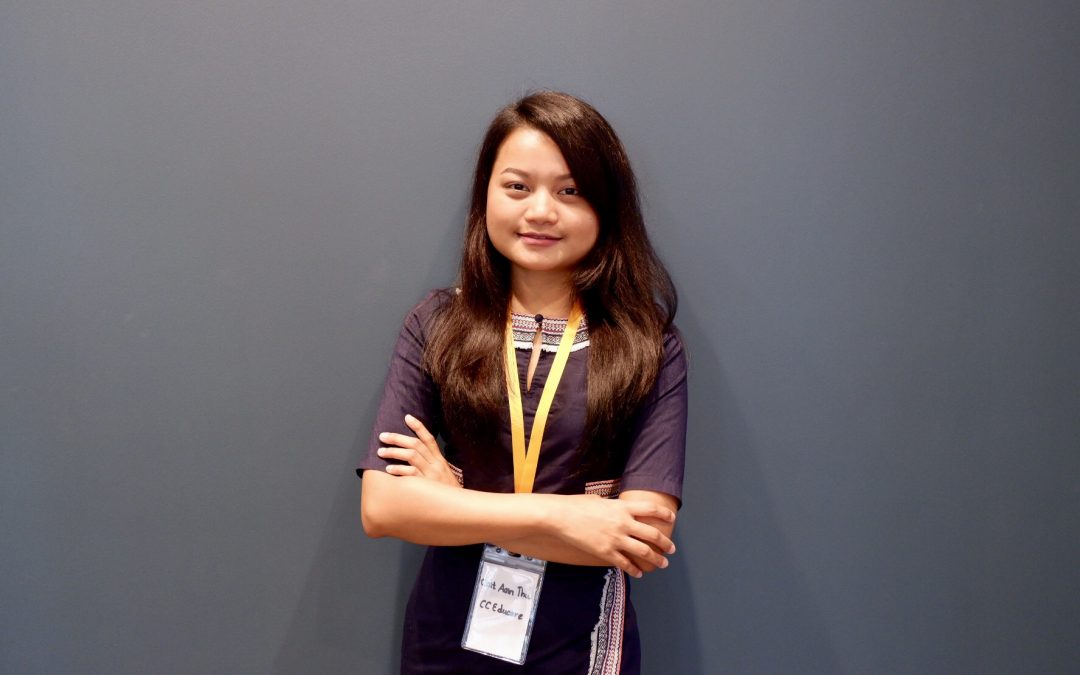
by So Jung Rim | Aug 6, 2018 | News
“Universities should play a main role to teach students to become more socially responsible and to also become more innovative.”
What’s your name? Tell us about yourself
My name is Chit Aein Thu, I am the Founder of CCEducare Myanmar, a social enterprise organization in Myanmar. I am an advocate for quality education and youth empowerment.
What do you think the most important social challenges are at the moment?
In our country, I believe that the education system is outdated and does not fit into the modern society anymore. The curriculums are no longer relevant and do not enable students in the real working life. At the same time, the access to quality education is very low, especially in Myanmar.
What are you doing to address this challenge or what do you hope to do?
I am currently introducing online learning to reduce the limitation of quality education access using information technology. We envision Myanmar to become a country where all the students can have access to equal education.
How do you think students and young people can play a role in helping solve these challenges?
Students should be encouraged to become innovative and to solve challenges outside of normal means.
What did you learn at the SEASIN studio?
During the SEASIN Studio, I learned how social challenges involve the consideration of related parties and their efforts and also how actions can be planned well in advance through the design workshop.
Has the SEASIN studio introduced you to new ways of thinking/working? Has it changed your perspective or your behaviour?
Yes, SEASIN Studio taught me new ways of thinking and more effective designing in creating solutions.

What does ‘social innovation’ mean to you?
To me, ‘social innovation’ is being creative and discovering new ways of solving social issues to improve better communities.
Do you think it is important that universities play a role in the community that is more than as academia?
Definitely yes. Universities should play a main role to teach students to become more socially responsible and to also become more innovative.
What can universities do to help students become better problem solvers of future challenges?
There will always be new challenges that we will face in the future. Universities can teach students the innovation process steps such as identifying the problem, generating an idea, and then implementing and monitoring those ideas.
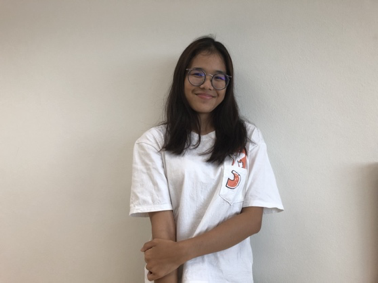
by So Jung Rim | Jul 25, 2018 | CU SISU, News
What’s your name? Tell us a bit about yourself.
My name is Waranya Chaiyapoomsakun and I’m a third year student studying at Faculty of Social Science. My major is Political Science. I have a passion to work with kids.
What do you think the most important social challenges are at the moment? (In your city? Or in your country? Or globally?)
The most important social challenge in my opinion is education. I used to study at the Opportunity Expansion School and the quality of teaching and academic resources were not as good as other schools at the same level. One teacher taught various subjects but he or she was not qualified to teach due to lack of proper knowledge in subjects they taught. As a result, students’ knowledge was limited and not good enough to be improved.
What are you doing to address this challenge or what do you hope to do?
I joined the English club and there were some foreign volunteers to teach English to us who lived up-country. Both teachers and students were satisfied with studying with foreign teachers so O-Net scores of our school were higher and kids were not afraid of talking to foreigners.
How do you think students/young people can play a role in helping solve these challenges?
Yes. Doing volunteer work up-country, sharing knowledge to kids, creating children’s books, helping build a library or doing whatever you are good at to help kids get more opportunities for learning were great.
What did you learn at the SEASIN studio?
I’ve learned from taking part in activities such as group discussion on the most important problems we’ve faced today in order to share our idea and try to think out of the box. It’s also a way to find solutions for people who have common problems.
Has the SEASIN studio introduced you to new ways of thinking/working? Has it changed your perspective or your behaviour?
Yes, but I thought the workshop length was too short so we were not able to find new thinking process clearly. Joining SEASIN studio made me change a bit anyway. When it comes to joining activities, I used to focus only on myself but after I joined this activity, I tend to listen more to surrounding people and my team to achieve our objectives.
What does ‘social innovation’ mean to you?
It could probably mean cooperation by various factors in society gathering together to solve problems effectively and in the long run. Activities can be conducted such as launching projects to deal with unresolved issues.
Do you think it is important that universities play a role in the community that is more than as academia?
I think it’s important because universities can guarantee and build up trust. If universities take part in any activities, people or participants are likely to have trust that it will have more chance to be successful as the reputation of university is something they can trust on.
What can universities do to help students become better problem solvers of future challenges?
Universities can provide spaces for students to share problems they’ve faced through activities or student clubs and they could finally find the best solutions to tackle problems occurred.
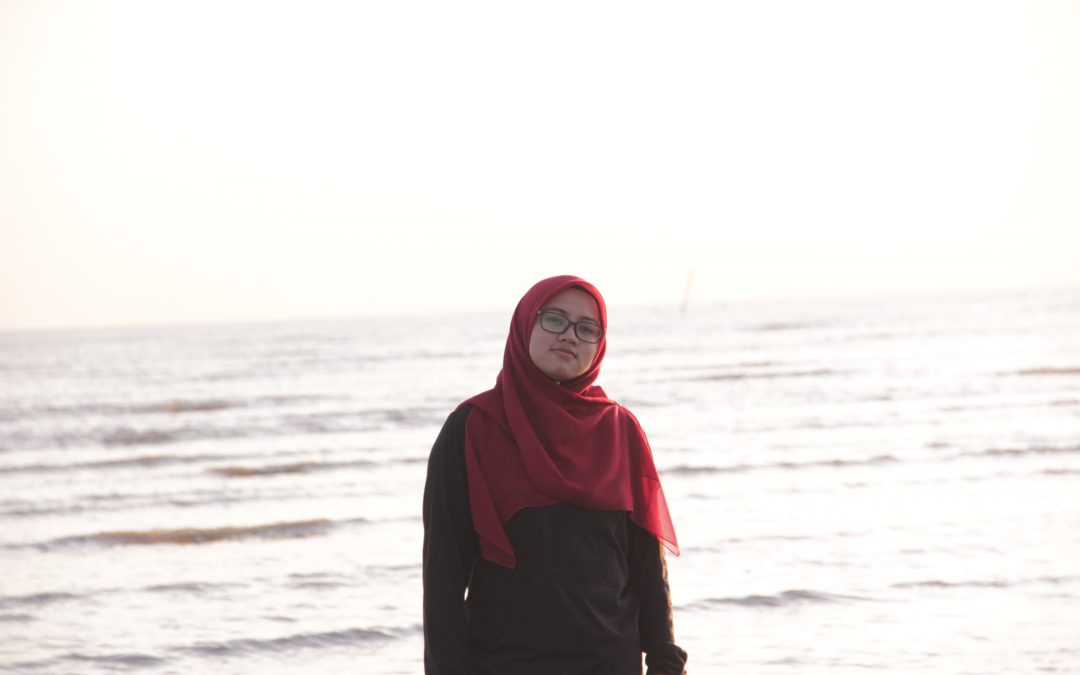
by So Jung Rim | Jul 10, 2018 | News, UiTM SISU
What’s your name? Tell us a bit about yourself.
My name is Farah Syuhada and I am a masters students in UiTM Shah Alam. I am passionate about creating possible solutions of existing problems and helping others in achieving a better quality life – no matter how small or how big it might be.
What do you think the most important social challenges are at the moment?
As of recently, there are worries of how graduates from educational courses, especially, are still unemployed despite graduated since a year ago and have gone through the interview process in order to be an educator.
What are you doing to address this challenge or what do you hope to do?
Coming from educational courses myself, it does worries me a little. However, students or graduates (not only graduates from educational faculty) have to take initiative for themselves. What I did in order to overcome it myself is to engage in different skills that could potentially be useful in future employments. What I hope to do is to create awareness on the self-initiative strategy that the graduates can employ in order to get hired. What I also hope to do is to create awareness and platform somewhere along the sayings that goes ‘if they cannot get the jobs, create them’.
How do you think students/young people can play a role in helping solve these challenges?
The most important role the students might have to take on is being the workforce in translating ideas into actual work. Since students are mostly young and healthy, they should take on these challenges head on. With the guidance of lecturers and supervisors, students can also be the generator of possible ideas and creators of innovation that could actually be used in solving certain social problems.
What did you learn at the SEASIN studio?
What I learnt for the SEASIN studio was that in creating solutions, you need different sets of eyes in helping to create a flawless and ideal solutions. Different perspectives brings out different angles that needed to be looked upon which is impossible to do alone. Networking and strategies about executing it are also part of the lessons that I’ve learnt.
Has the SEASIN studio introduced you to new ways of thinking/working? Has it changed your perspective or your behaviour?
It definitely introduced me to brilliant ideas and new ways of working/thinking that really gave me different perspectives in social innovation. It does not necessarily change my perspective but it really does add on, on my views of certain things.
What does ‘social innovation’ mean to you?
Social innovations are new strategies, solutions and ideas in meeting the needs of social challenges that could create a better quality in civil community.
Do you think it is important that universities play a role in the community that is more than as academia? How?
I think universities have the greatest degree of roles in the community as they have the educators and students that not only act as the workforce but also act as hubs in creating ideas and solutions to the problems at hand. Universities also have one of the largest networking that would help in approaching those problems.
What can universities do to help students become better problem solvers of future challenges?
In my opinion, universities should create or create hubs/centres where students of different courses background can submit ideas and those ideas will be openly discussed among the students in order to fill in the gaps or loopholes that might be overlooked. This ways, students’ ideas are not totally dismissed but improved upon. Not only that, involving students from different backgrounds of courses will give them a glimpse of what other problems that might exist outside of their own capacity of their own learning. These hopefully will create a better environment to create students with great problem-solving and innovation skills.
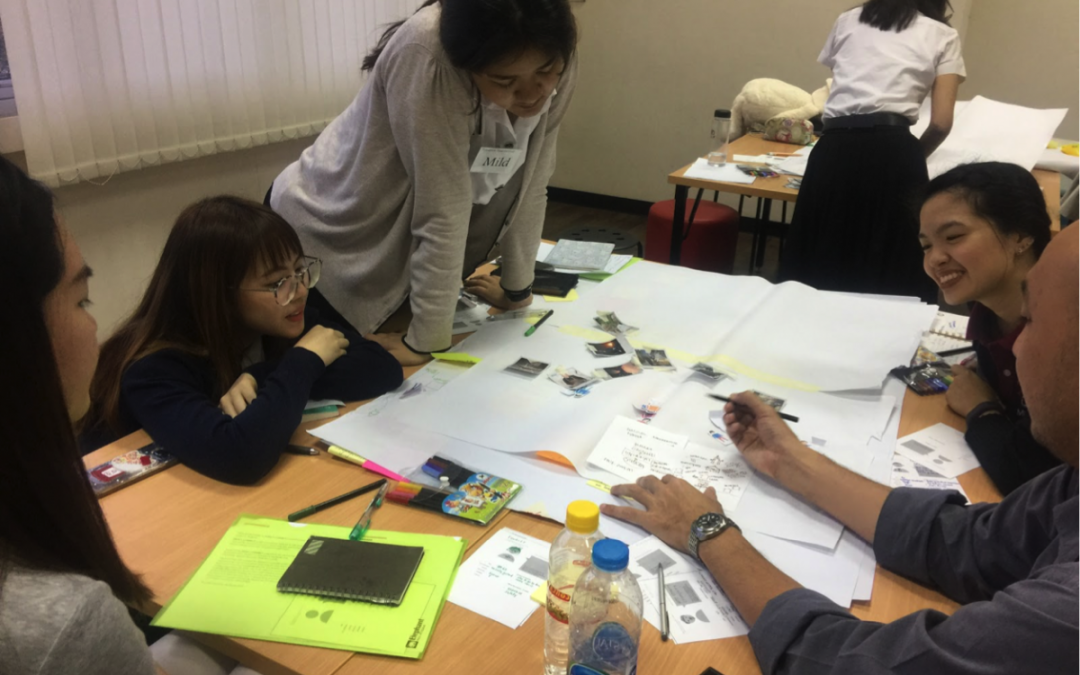
by So Jung Rim | Apr 20, 2018 | News
By So Jung Rim and Julie Munk
“There is no people power in this country”
Participant during the social innovation workshop in Myanmar
The above quote is rather representative of our recent experience of running social innovation training workshops and meeting young students in South East Asia. Another participant in Myanmar used an analogy to express the frustration he felt. “We are like frogs in a cup. Frogs can normally jump high, but if you keep them inside a cup with a lid on, they get used to jumping only as high as the cup will allow them. Even if the lid is removed later, the frog won’t jump higher than the height of the cup.”
In Thailand, similar sentiments were expressed by young people. ‘Young people don’t have freedom here. We are restricted by what the society think young people should do and what our parents think we should do. We are not allowed to think for ourselves and make choices about our career and lives.’
These honest thoughts and frustrations shared by participants at two recent SIX facilitated social innovation events in Myanmar and Thailand made us think about the link between agency and structure in a social change process: What does it take for social innovation to flourish in a society? Where does change start? Is it about capacity of individuals to act? Or do social structures determine what we can do?
Enabling social innovation does not only raise questions and needs for shared insights and knowledge. It is not only a question of access to best practice stories and tools. For social innovation to flourish, systems have to be open, whilst practice and tools have to be embedded within individuals. Both aspects of this hold equal importance and are always interlinked.
What we see when working with contexts, cultures and systems like those in Myanmar and Thailand, the mindset of a social innovation isn’t systematically supported and celebrated as a human and individual skill. Likewise shifting systems where difference is not valued and failure is not tolerated can require enormous individual courage.
However despite these factors, during the process of this 2-day SEASIN Social Innovation Studio workshop, we saw amazing team work where diverse participants (students and practitioners) discussed, imagined and collaborated to craft potential solutions to social challenges they face,This provided evidence and experience of how knowledge, emotions and power to drive social change can be hidden and almost suppressed within individuals.

The use of design principles, such as role play and scenario building based on user-centred ethnography around real-life challenges, can help as techniques to open up for insights and knowledge that are otherwise hidden. It is easier to ‘play it out’ when you are given imaginary realities and when you are in a safe space in which you can articulate observed and identified problems.
Universities hold a key role in enabling these kind of safe spaces for ideation and problem solving around social complexity. Not only with activities like the studios but also in everyday practice. Universities are able to provide these spaces and imaginary worlds where individuals can build agency and feel empowered to implement social innovation practice within the system they are part of.
This article was originally published on the Social Innovation Exchange website.
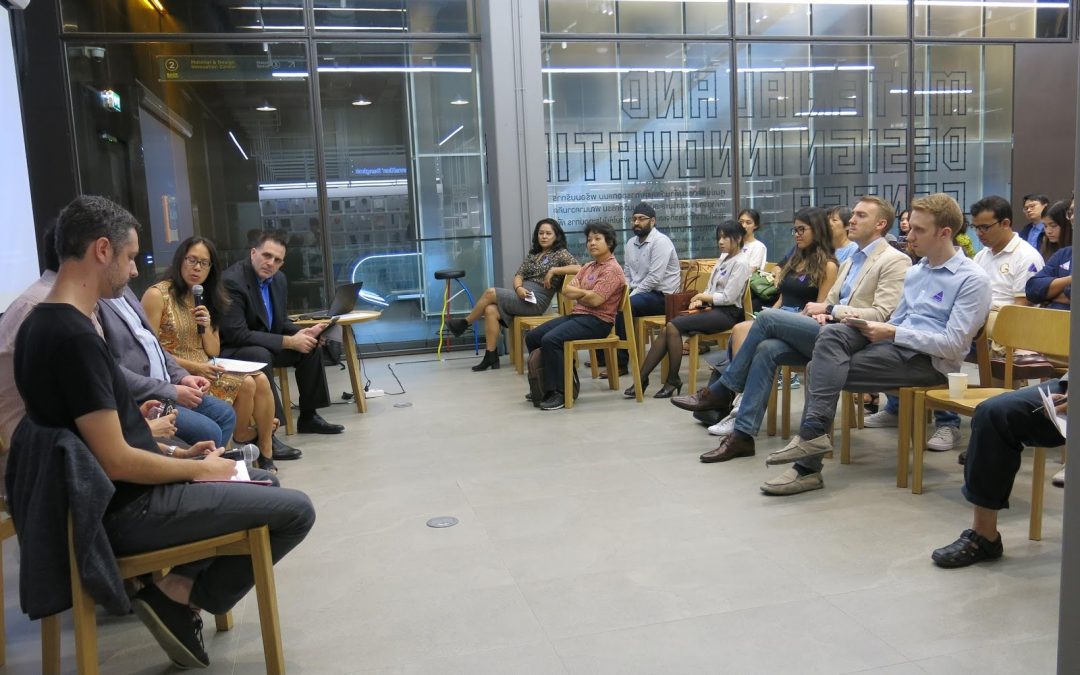
by So Jung Rim | Mar 15, 2018 | News, TU SISU
In November 2017, the Thammasat SEASIN team organised an event looking at the Future of Social Innovation Ecosystems in Thailand and Beyond. Panelists included representatives from the head of UNDP’s social innovation team, the head of UNICEF’s social innovation team, the founder of ChangeFusion, a Bangkok based social impact incubator, and the CEO of Tandemic, a Malaysia based social innovation and design thinking firm. This event was a part of The School of Global Studie’s ‘What The Future?!’ an event that aims to strengthen the social impact community in Bangkok.
The speaker series event brings together experts in the realm of social innovation to discuss global social challenges relevant to the region. The first half of the event is an interactive panel discussion where questions for the panel are crowd sourced from the audience. For the second half of the event the audience is broken up into smaller groups that are joined by a panelists to have more intimate discussions which allows everyone the chance to participate, share their knowledge, and discuss big topics at a micro level.


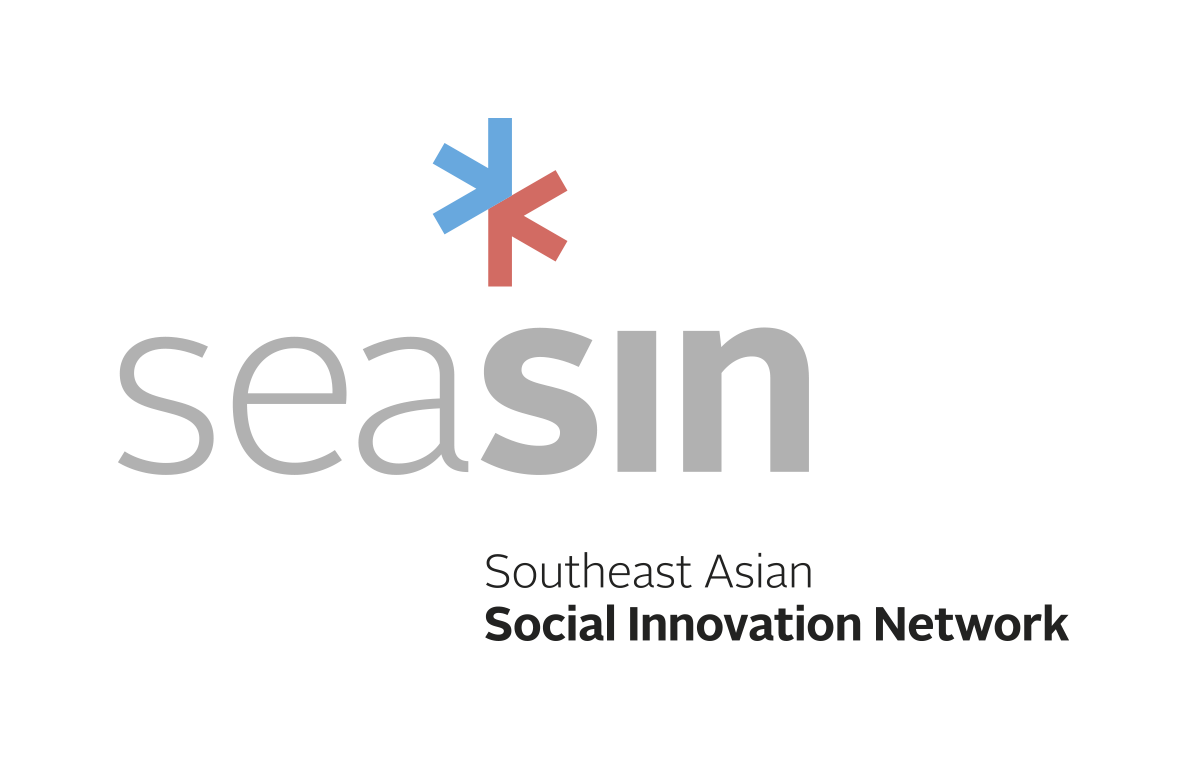





Recent Comments